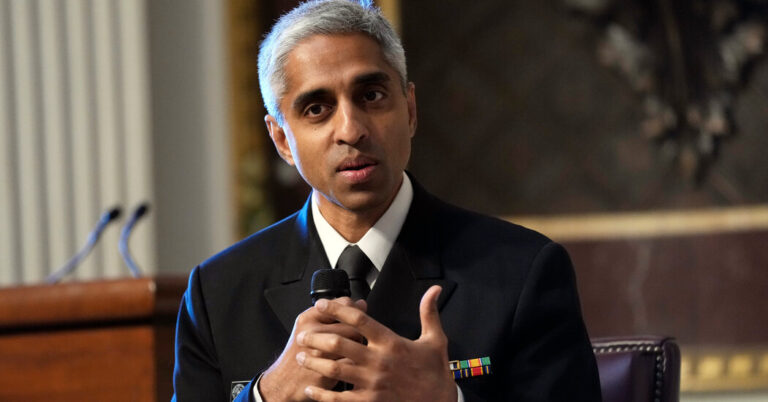US Surgeon General Dr. Vivek Murthy said Monday he would encourage social media platforms to require labels to warn parents that their use could harm adolescents’ mental health.
Warning labels, like those on tobacco and alcohol products, are among the most powerful tools available to the country’s top health official, but Dr. Mursi cannot unilaterally mandate them. The measure would require congressional approval. No such bill has yet been introduced in either chamber of Congress.
Warning labels would send a strong message to parents that “social media has not been proven safe,” Dr. Murthy wrote in an opinion essay published Monday in The New York Times.
In his essay, he characterized the impact of social media on children and young people as a public health risk on par with traffic deaths or contaminated food.
“Why are we failing to address the harms of social media, which are as urgent and pervasive as those caused by unsafe cars, planes, and food?” Dr. Murthy wrote. “These harms are not a failure of willpower or parenting, but the result of unleashing powerful technologies without sufficient safeguards, transparency, and accountability.”
Dr Murthy noted that research has shown that teenagers who spend more than three hours a day on social media are at significantly higher risk of mental health problems, and that 46% of teenagers say social media has made them feel bad about their body.
According to a Gallup survey of more than 1,500 adolescents released last fall, American teenagers spend an average of 4.8 hours a day on social media platforms such as YouTube, TikTok and Instagram.
In an interview last month, Dr Murthy said he had heard many stories of young people who were “stuck on the platform” only to realise hours had passed when they simply wanted to check their feed.
“These platforms are designed to maximize the time we spend on them,” he said. “It’s one thing to do that with adults, but it’s another to do that with children, whose impulse control is still developing and whose brains are at a sensitive stage of development.”
Warning labels in the past have had a major impact on behavior: In 1965, following a landmark report by the Surgeon General, Congress passed a resolution requiring all tobacco packages distributed in the United States to carry a warning that use of the product “may be dangerous to health.”
It was the start of a 50-year decline in smoking: When the warning labels were introduced, about 42% of U.S. adults smoked cigarettes daily; by 2021, that percentage had fallen to 11.5%.
Researchers are fiercely debating whether social media is to blame for the mental health crisis among children and adolescents. In his new book, “The Anxious Generation,” social psychologist Jonathan Haidt points to the launch of Apple’s iPhone in 2007 as a tipping point, when reports of suicidal behavior and despair soared.
Other experts say that while the rise of social media and the decline in happiness have occurred simultaneously, there is no evidence that one caused the other, pointing instead to factors such as economic hardship, social isolation, racism, school shootings and the opioid crisis.
Dr Murthy has previously suggested he sees social media as a health risk: in May 2023, he published an advisory on the subject, warning that “there is ample evidence that social media may cause serious harm to the mental health and wellbeing of children and adolescents.”
In his statement, Dr Murthy acknowledged that the impact of social media on adolescent mental health is not fully understood, but research suggests it poses both risks and benefits, providing a community for young people who might otherwise feel alienated.
Still, parents were urged to immediately set limits on their children’s social media use and to keep devices off during meal times.
By calling for warning labels, Dr Murthy further emphasizes the urgency.
“One of the most important lessons I learned in medical school is that in an emergency, you cannot afford to wait for perfect information,” he wrote. “Evaluate the available facts, use your best judgment, and act quickly.”
He recalled the words of a tearful mother whose child committed suicide after being bullied online, and compared the current situation to groundbreaking public health campaigns of the past.
“There are no seat belts for parents to click, no helmets to snap on, and no guarantee that trusted experts have vetted and verified these platforms as safe for children,” he wrote. “Parents and kids are left trying to figure out the solutions themselves, up against the best product engineers and best-resourced companies in the world.”

